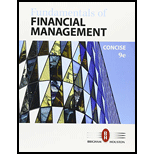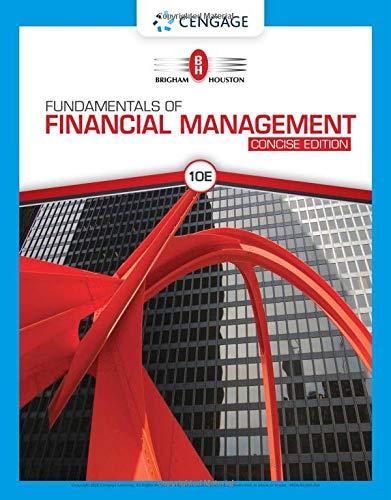
a.
To compute: The net operating working capital for 2015 and 2016.
Balance sheet is a part of the financial statements that lists the company’s assets, liabilities and shareholders’ fund. It is prepared at last of the accounting period and informs about company’s financial position on that day.
Income Statement:
A part of the financial statements that lists the income and expenses of business for an accounting year is called income statement. It is prepared at the end of accounting period to know the profitability of the` business.
b.
To compute: The
Free Cash Flow:
The cash generated over and above required by business operations and capital expenditure is called free cash flow. Statement of cash flow reports the cash flow generated or consumed by the business.
c.
To explain: The large increase in dividends in 2016.
Balance sheet:
Balance sheet is a part of the financial statements that lists the company’s assets, liabilities and shareholders’ fund. It is prepared at last of the accounting period and informs about company’s financial position on that day.
Income Statement:
A part of the financial statements that lists the income and expenses of business for an accounting year is called income statement. It is prepared at the end of accounting period to know the profitability of the` business.
Want to see the full answer?
Check out a sample textbook solution
Chapter 3 Solutions
Fundamentals of Financial Management, Concise Edition
- Wilbur and Orville are brothers. They're both serious investors, but they have different approaches to valuing stocks. Wilbur, the older brother, likes to use the dividend valuation model. Orville prefers the free cash flow to equity valuation model. As it turns out, right now, both of them are looking at the same stock-Wright First Aerodynmaics, Inc. (WFA). The company has been listed on the NYSE for over 50 years and is widely regarded as a mature, rock-solid, dividend-paying stock. The brothers have gathered the following information about WFA's stock: Current dividend (D) = $2.30/share Current free cash flow (FCF) = $1.5 million Expected growth rate of dividends and cash flows (g) = 5% Required rate of return (r) = 14% Shares outstanding 500,000 shares How would Wilbur and Orville each value this stock?arrow_forwardCompany P/S Multiples Facebook 13.33 Snap 18.22 Twitter 13.27arrow_forwardThe Perez Company has the opportunity to invest in one of two mutually exclusive machines that will produce a product it will need for the foreseeable future. Machine A costs $8 million but realizes after-tax inflows of $4.5 million per year for 4 years. After 4 years, the machine must be replaced. Machine B costs $17 million and realizes after-tax inflows of $4 million per year for 8 years, after which it must be replaced. Assume that machine prices are not expected to rise because inflation will be offset by cheaper components used in the machines. The cost of capital is 13%. Using the replacement chain approach to project analysis, by how much would the value of the company increase if it accepted the better machine? Round your answer to two decimal places. 1.) $ millionarrow_forward
- Wilbur and Orville are brothers. They're both serious investors, but they have different approaches to valuing stocks. Wilbur, the older brother, likes to use the dividend valuation model. Orville prefers the free cash flow to equity valuation model. As it turns out, right now, both of them are looking at the same stock-Wright First Aerodynmaics, Inc. (WFA). The company has been listed on the NYSE for over 50 years and is widely regarded as a mature, rock-solid, dividend-paying stock. The brothers have gathered the following information about WFA's stock: Current dividend (D) = $3.30/share Current free cash flow (FCF) = $1.5 million Expected growth rate of dividends and cash flows (g)=8% Required rate of return (r) = 13% Shares outstanding 500,000 shares How would Wilbur and Orville each value this stock? The stock price from Wilbur's valuation is $ (Round to the nearest cent.)arrow_forwardThe Perez Company has the opportunity to invest in one of two mutually exclusive machines that will produce a product it will need for the foreseeable future. Machine A costs $8 million but realizes after-tax inflows of $4.5 million per year for 4 years. After 4 years, the machine must be replaced. Machine B costs $17 million and realizes after-tax inflows of $4 million per year for 8 years, after which it must be replaced. Assume that machine prices are not expected to rise because inflation will be offset by cheaper components used in the machines. The cost of capital is 13%. Using the replacement chain approach to project analysis, by how much would the value of the company increase if it accepted the better machine? Round your answer to two decimal places. 1.) $ million What is the equivalent annual annuity for each machine? Do not round intermediate calculations. Round your answers to two decimal places. 2.) Machine A: $ million 3.) Machine B: $ millionarrow_forwardYou expect to have $29,865. You plan to make X savings contribution of $1,690 per month. The expected return is 0.92 percent per month and the first regular savings contribution will be made later today. What is X? Round to 2 decimal places.arrow_forward
- Company P/S Multiples Facebook 13.67 Snap 18.76 Twitter 13.55arrow_forwardEnergy Resources generated an EPS of $4.38 over the last 12 months. The company's earnings are expected to grow by 30.7% next year, and because there will be no significant change in the number of shares outstanding, EPS should grow at about the same rate. You feel the stock should trade at a P/E of around 30 times earnings. Use the P/E approach to set a value on this stock. Using the P/E approach, the value on this stock is $ (Round to the nearest cent.)arrow_forwardThe Anderson Company has a net profits of $20 million, sales of $226 million, and 3.9 million shares of common stock outstanding. The company has total assets of $139 million and total stockholders' equity of $74 million. It pays $2.31 per share in common dividends, and the stock trades at $40 per share. Given this information, determine the following: a. Anderson's EPS. b. Anderson's book value per share and price-to-book-value ratio. c. The firm's P/E ratio. d. The company's net profit margin. e. The stock's dividend payout ratio and its dividend yield. f. The stock's PEG ratio, given that the company's earnings have been growing at an average annual rate of 8.2%. a. Anderson's EPS is $ (Round to the nearest cent.)arrow_forward
- Davis Industries must choose between a gas-powered and an electric-powered forklift truck for moving materials in its factory. Because both forklifts perform the same function, the firm will choose only one. (They are mutually exclusive investments.) The electric-powered truck will cost more, but it will be less expensive to operate; it will cost $23,000, whereas the gas-powered truck will cost $17,100. The cost of capital that applies to both investments is 11%. The life for both types of truck is estimated to be 6 years, during which time the net cash flows for the electric-powered truck will be $6,500 per year, and those for the gas-powered truck will be $4,750 per year. Annual net cash flows include depreciation expenses. Calculate the NPV and IRR for each type of truck, and decide which to recommend. Do not round intermediate calculations. Round the monetary values to the nearest dollar and percentage values to two decimal places. Electric-poweredforklift truck…arrow_forwardA project has an initial cost of $45,000, expected net cash inflows of $9,000 per year for 11 years, and a cost of capital of 14%. What is the project's NPV? (Hint: Begin by constructing a time line.) Do not round intermediate calculations. Round your answer to the nearest cent.arrow_forwardA project has an initial cost of $45,000, expected net cash inflows of $9,000 per year for 11 years, and a cost of capital of 14%. What is the project's NPV? (Hint: Begin by constructing a time line.) Do not round intermediate calculations. Round your answer to the nearest cent.arrow_forward
 Fundamentals Of Financial Management, Concise Edi...FinanceISBN:9781337902571Author:Eugene F. Brigham, Joel F. HoustonPublisher:Cengage Learning
Fundamentals Of Financial Management, Concise Edi...FinanceISBN:9781337902571Author:Eugene F. Brigham, Joel F. HoustonPublisher:Cengage Learning Cornerstones of Financial AccountingAccountingISBN:9781337690881Author:Jay Rich, Jeff JonesPublisher:Cengage Learning
Cornerstones of Financial AccountingAccountingISBN:9781337690881Author:Jay Rich, Jeff JonesPublisher:Cengage Learning Financial Accounting: The Impact on Decision Make...AccountingISBN:9781305654174Author:Gary A. Porter, Curtis L. NortonPublisher:Cengage Learning
Financial Accounting: The Impact on Decision Make...AccountingISBN:9781305654174Author:Gary A. Porter, Curtis L. NortonPublisher:Cengage Learning


